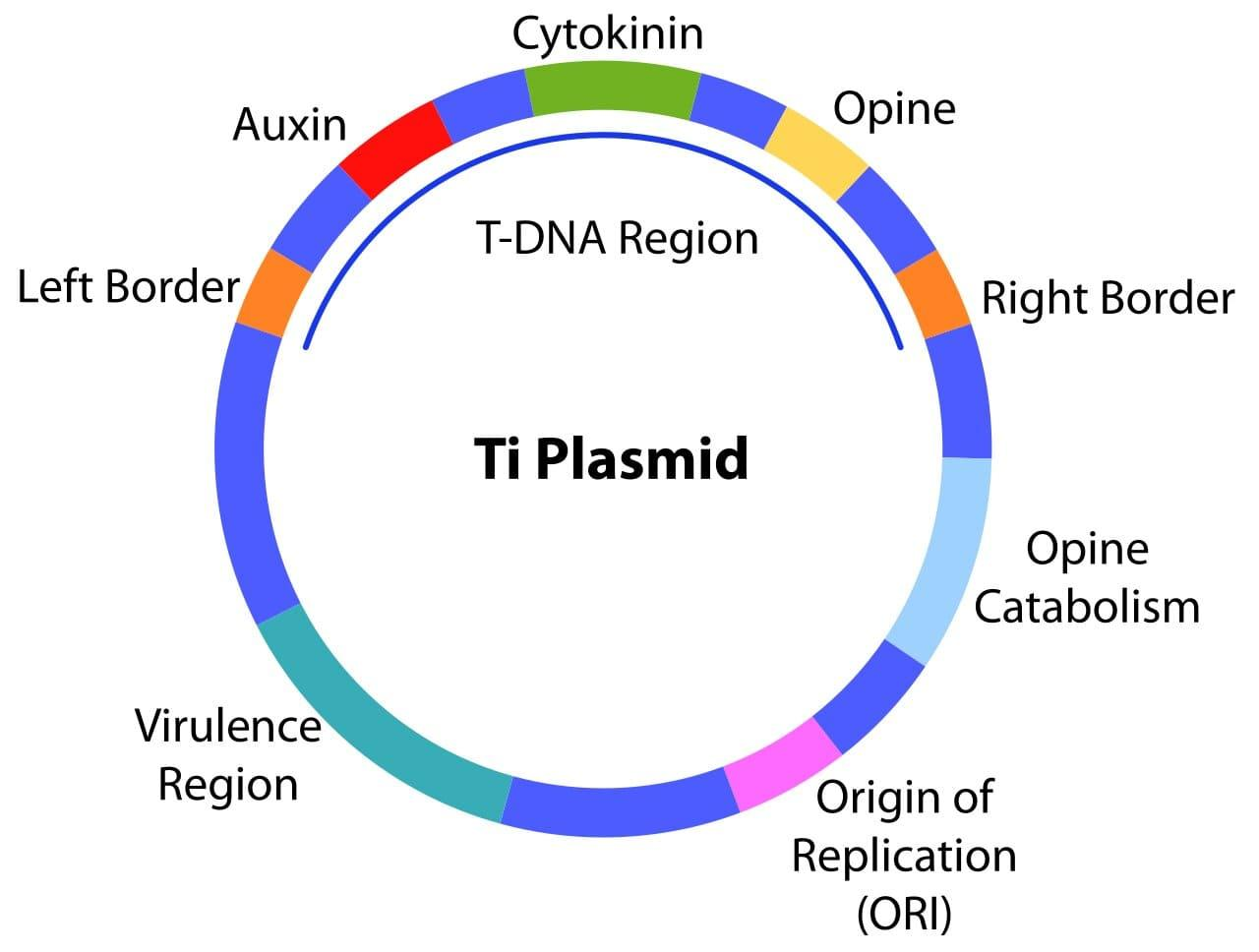Answer
390k+ views
Hint: Ti plasmid is found in soil bacteria that induce tumour formation in plants. It is used to transfer a specific segment of DNA(T-DNA) in the host cell/genome.
Step by step answer:Agrobacterium tumefaciens is a bacterium found in soil. It is pathogenic for plants and carries Ti plasmid. The Ti or tumor-inducing plasmid carries the genes that can induce tumor formation in plants. It is able to transfer a specific segment of the plasmid into the nucleus of infected cells. This segment is called T-DNA. The transferred T-DNA integrates into the host genome. As the transcription occurs in the host genome, T-DNA also gets transcribed. The ability of the bacterium Agrobacterium tumefaciens to transfer T-DNA in the host genome is made use of in genetic engineering. This principle is used to transfer the desired DNA segment, carrying the gene of the interest into the genome of the target organisms. Azotobacter is a genus of aerobic soil bacteria involved in the fixation of atmospheric nitrogen. They do not carry the Ti plasmid and hence cannot induce tumor formation in plants. From yeast, 4 types of plasmid vectors have been developed, viz. Yeast Episomal Plasmids (YEPs), Yeast Replicating Plasmids (YRPs), Yeast Centromere Plasmids (YCPs), and Yeast Artificial Chromosomes (YACs). These plasmids have unique restriction sites and can replicate within E. coli at high copy number but they do not carry Ti plasmid and cannot induce tumors in plant cells. In Rhizobium the roots of leguminous plants remain in a symbiotic relationship. They also fix atmospheric nitrogen.

So, the correct answer is D, i.e.,Agrobacterium
Note: The T-DNA segment contains right and left border sequences along with plant hormone coding genes, e.g. auxin, cytokinin, etc. These auxin and cytokinin are plant growth hormones that help the plant to promote its growth.
Step by step answer:Agrobacterium tumefaciens is a bacterium found in soil. It is pathogenic for plants and carries Ti plasmid. The Ti or tumor-inducing plasmid carries the genes that can induce tumor formation in plants. It is able to transfer a specific segment of the plasmid into the nucleus of infected cells. This segment is called T-DNA. The transferred T-DNA integrates into the host genome. As the transcription occurs in the host genome, T-DNA also gets transcribed. The ability of the bacterium Agrobacterium tumefaciens to transfer T-DNA in the host genome is made use of in genetic engineering. This principle is used to transfer the desired DNA segment, carrying the gene of the interest into the genome of the target organisms. Azotobacter is a genus of aerobic soil bacteria involved in the fixation of atmospheric nitrogen. They do not carry the Ti plasmid and hence cannot induce tumor formation in plants. From yeast, 4 types of plasmid vectors have been developed, viz. Yeast Episomal Plasmids (YEPs), Yeast Replicating Plasmids (YRPs), Yeast Centromere Plasmids (YCPs), and Yeast Artificial Chromosomes (YACs). These plasmids have unique restriction sites and can replicate within E. coli at high copy number but they do not carry Ti plasmid and cannot induce tumors in plant cells. In Rhizobium the roots of leguminous plants remain in a symbiotic relationship. They also fix atmospheric nitrogen.

So, the correct answer is D, i.e.,Agrobacterium
Note: The T-DNA segment contains right and left border sequences along with plant hormone coding genes, e.g. auxin, cytokinin, etc. These auxin and cytokinin are plant growth hormones that help the plant to promote its growth.
Recently Updated Pages
Basicity of sulphurous acid and sulphuric acid are

What is the stopping potential when the metal with class 12 physics JEE_Main

The momentum of a photon is 2 times 10 16gm cmsec Its class 12 physics JEE_Main

Using the following information to help you answer class 12 chemistry CBSE

Which of the following would not be a valid reason class 11 biology CBSE

Why should electric field lines never cross each other class 12 physics CBSE

Trending doubts
Difference Between Plant Cell and Animal Cell

Difference between Prokaryotic cell and Eukaryotic class 11 biology CBSE

Draw a diagram showing the external features of fish class 11 biology CBSE

Fill the blanks with the suitable prepositions 1 The class 9 english CBSE

Give 10 examples for herbs , shrubs , climbers , creepers

Fill the blanks with proper collective nouns 1 A of class 10 english CBSE

Change the following sentences into negative and interrogative class 10 english CBSE

Select the word that is correctly spelled a Twelveth class 10 english CBSE

How fast is 60 miles per hour in kilometres per ho class 10 maths CBSE



